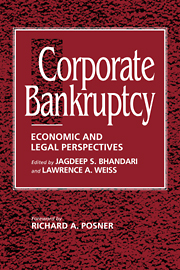Book contents
- Frontmatter
- Contents
- List of tables and figures
- Foreword by the HONORABLE RICHARD A. POSNER
- Preface
- Part I The role of credit
- Part II Bankruptcy as a reflection of the creditors' implicit bargain
- Part III Beyond the basic creditors' bargain
- 9 Bargaining after the fall and the contours of the absolute priority rule
- 10 On the nature of bankruptcy: An essay on bankruptcy sharing and the creditors' bargain
- 11 A simple noncooperative bargaining model of corporate reorganizations
- 12 Commentary on “On the nature of bankruptcy”: bankruptcy, priority, and economics
- 13 Bankruptcy and risk allocation
- 14 The corporate bankruptcy decision
- 15 Bargaining over equity's share in the bankruptcy reorganization of large, publicly held companies
- 16 Bankruptcy resolution: Direct costs and violation of priority of claims
- 17 The costs of conflict resolution and financial distress: Evidence from the Texaco-Pennzoil litigation
- 18 Survey of evidence on business bankruptcy
- Part IV Workouts or bargaining in the shadow of bankruptcy
- Part V Alternatives to bankruptcy and the creditors' bargain
- Part VI Experience of other countries
- Index
12 - Commentary on “On the nature of bankruptcy”: bankruptcy, priority, and economics
Published online by Cambridge University Press: 10 December 2009
- Frontmatter
- Contents
- List of tables and figures
- Foreword by the HONORABLE RICHARD A. POSNER
- Preface
- Part I The role of credit
- Part II Bankruptcy as a reflection of the creditors' implicit bargain
- Part III Beyond the basic creditors' bargain
- 9 Bargaining after the fall and the contours of the absolute priority rule
- 10 On the nature of bankruptcy: An essay on bankruptcy sharing and the creditors' bargain
- 11 A simple noncooperative bargaining model of corporate reorganizations
- 12 Commentary on “On the nature of bankruptcy”: bankruptcy, priority, and economics
- 13 Bankruptcy and risk allocation
- 14 The corporate bankruptcy decision
- 15 Bargaining over equity's share in the bankruptcy reorganization of large, publicly held companies
- 16 Bankruptcy resolution: Direct costs and violation of priority of claims
- 17 The costs of conflict resolution and financial distress: Evidence from the Texaco-Pennzoil litigation
- 18 Survey of evidence on business bankruptcy
- Part IV Workouts or bargaining in the shadow of bankruptcy
- Part V Alternatives to bankruptcy and the creditors' bargain
- Part VI Experience of other countries
- Index
Summary
Exogenous Risks Versus Endogenous Risks: The Only Relevant Distinction?
Dean Jackson and Professor Scott [referring to Chapter 10 in this volume. Eds.] provide us with a vivid image: the captain of an imperiled ship must decide whether to jettison cargo, to cut off the mast, or to jettison the ship's supplies. If losses fall where incurred and are not shared, the captain would be expected to foster his own interest instead of maximizing the savings of the group. Admiralty's rule of general average reduces the captain's perverse incentive to jettison another participant's cargo when it is cheaper in the aggregate to jettison the ship's own supplies.
Bankruptcy's priority system recreates the imperiled ship scenario. Deviations from the priority system for exogenous risks are analogous to admiralty's rule of general average. The parties could do nothing to avoid the calamity or to mitigate its effects. The costs of bargaining to the value-maximizing solution are high due to priority. Accordingly, the theoretical justification for respecting priority in a bankruptcy caused by exogenous factors evaporates.
Strategic creditor action, they argue, justifies bankruptcy's sharing rules. Another justification is available – debtor moral hazard: if the owner of a closely held firm fears that his equity interest will be reduced to zero, he has an incentive to abandon the enterprise or to take unwarranted risks to create some possibility of a payback. By giving the entrepreneurial debtor an interest in the ongoing enterprise, sharing rules mute his incentive to gamble with, or to abandon, the enterprise.
- Type
- Chapter
- Information
- Corporate BankruptcyEconomic and Legal Perspectives, pp. 181 - 189Publisher: Cambridge University PressPrint publication year: 1996



